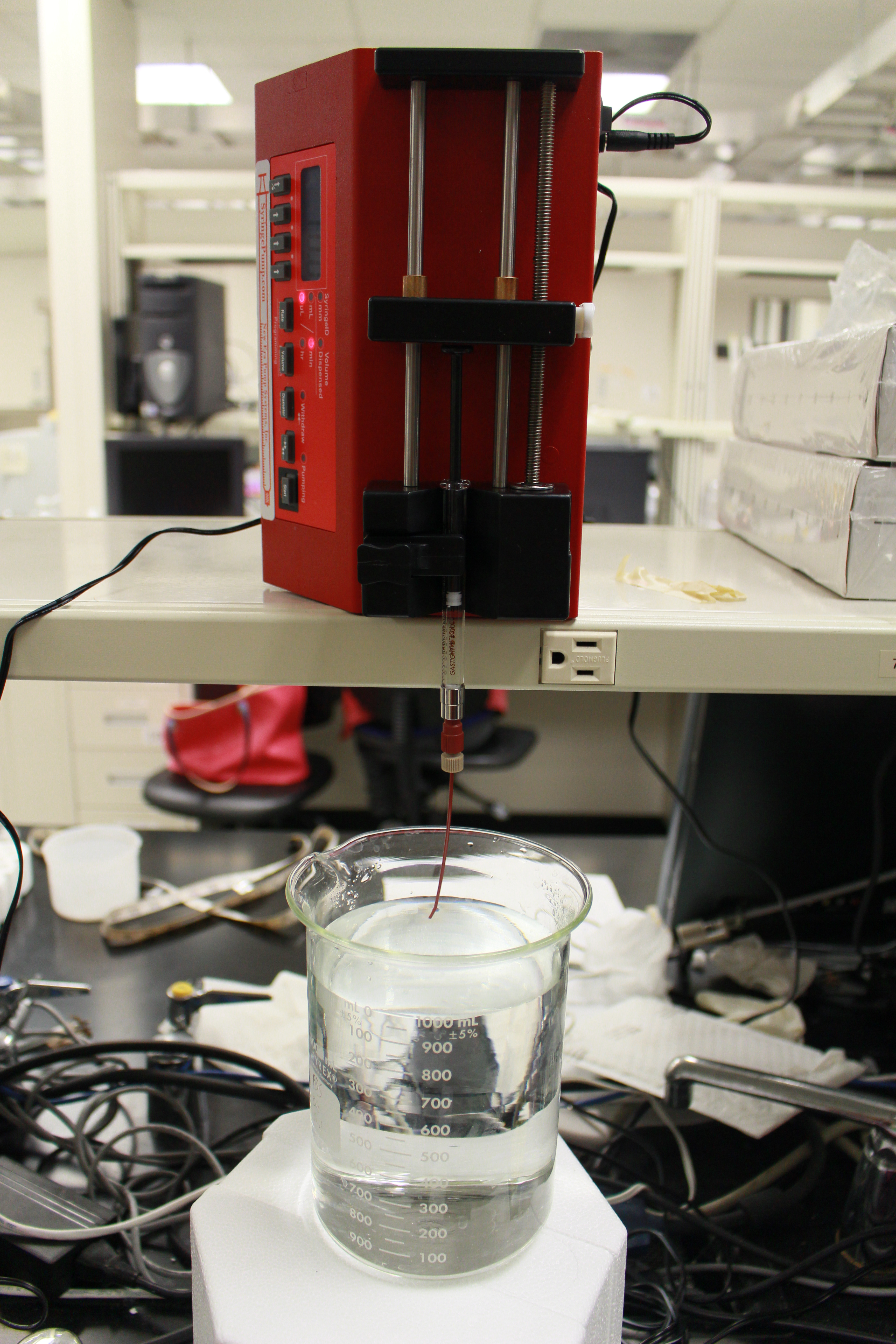Team:UCLA/Project/Spinning Silk
From 2014.igem.org
Michaelc1618 (Talk | contribs) |
Michaelc1618 (Talk | contribs) |
||
| Line 51: | Line 51: | ||
<p>The standard method that we are using to produce silk fibers is syringe extrusion, in which a syringe pump forces silk dope through a small-diameter tube into a liquid coagulation bath. This method most directly emulates the process that spiders use. In a natural spider spinneret, silk solution produced in the spider's glands are forced through small-diameter spinnerets, and expelled as solid threads.</p> | <p>The standard method that we are using to produce silk fibers is syringe extrusion, in which a syringe pump forces silk dope through a small-diameter tube into a liquid coagulation bath. This method most directly emulates the process that spiders use. In a natural spider spinneret, silk solution produced in the spider's glands are forced through small-diameter spinnerets, and expelled as solid threads.</p> | ||
| - | <figure style= "margin: 10px; float: right;"><img src= "https://static.igem.org/mediawiki/2014/1/1c/Syringe_extruder.JPG" width = 25% height = 25% /><figcaption style="margin: auto;">Our team's syringe extruder. It consists of a gas chromatography syringe (Hamilton Co.) in a syringe pump (Pump Systems, Inc.)</figcaption></figure> | + | <a href = "https://static.igem.org/mediawiki/2014/1/1c/Syringe_extruder.JPG"><figure style= "margin: 10px; float: right;"><img src= "https://static.igem.org/mediawiki/2014/1/1c/Syringe_extruder.JPG" width = 25% height = 25% /><figcaption style="margin: auto;">Our team's syringe extruder. It consists of a gas chromatography syringe (Hamilton Co.) in a syringe pump (Pump Systems, Inc.)</figcaption></figure></a> |
<p>Another method that we are investigating is centrifuge extrusion, in which a column with a small-diameter channel is loaded with silk dope, and placed into a centrifuge tube containing the coagulation solution. The loaded column and tube are then centrifuged at high speeds, and the resulting centrifugal force extrudes the dope through the channel into the coagulation bath, causing a fiber to form.</p> | <p>Another method that we are investigating is centrifuge extrusion, in which a column with a small-diameter channel is loaded with silk dope, and placed into a centrifuge tube containing the coagulation solution. The loaded column and tube are then centrifuged at high speeds, and the resulting centrifugal force extrudes the dope through the channel into the coagulation bath, causing a fiber to form.</p> | ||
Revision as of 08:38, 17 October 2014





Processing Silk
Preparation for Silk Materials
Spinning Silk
In order to form fibers from silk, soluble silk protein solutions must be much like how they are in natural spider spinnerets. The majority of spinning methods entail pushing, or extruding, silk solution through very thin channels. During this extrusion, shear forces on the silk solution cause the amino acids of the proteins to align in a way that allows the strong beta sheets of the silk structure to form. Multiple proteins are similarly aligned, causing separate proteins to interact and form larger structures.
The standard method that we are using to produce silk fibers is syringe extrusion, in which a syringe pump forces silk dope through a small-diameter tube into a liquid coagulation bath. This method most directly emulates the process that spiders use. In a natural spider spinneret, silk solution produced in the spider's glands are forced through small-diameter spinnerets, and expelled as solid threads.

Another method that we are investigating is centrifuge extrusion, in which a column with a small-diameter channel is loaded with silk dope, and placed into a centrifuge tube containing the coagulation solution. The loaded column and tube are then centrifuged at high speeds, and the resulting centrifugal force extrudes the dope through the channel into the coagulation bath, causing a fiber to form.

A final method for fiber production that we worked with is rotary jet spinning. Rotary jet spinning is very similar to centrifuge extrusion, in that the dope is spun at very high speeds and centrifugal force pushes the dope out of the channel. However, in rotary jet spinning, the dope is loaded into a reservoir that is mounted vertically onto a motor shaft. This method does not allow for the usage of a coagulation bath, as the reservoir holding the dope must be spun in air. If the reservoir were to be spun in a liquid bath, the resultant turbulence in the bath would cause structural instability and destroy the apparatus.
[PICTURE of rotary jet spinner]Post-Spin Stretch
A very important part of creating fibers from expressed recombinant silk is the stretching of the fiber after it has been extruded. This can be observed in actual spiders, who tug on the silk threads they produce in order to stretch them. This stretching not only results in longer lengths of threads to work with, it confers extra strength and elasticity to the fibers.
 "
"
